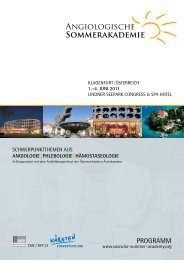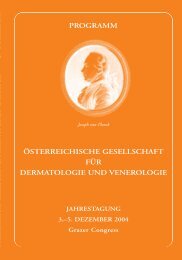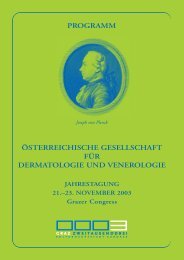PROGRAMM JAHRESTAGUNG 2012 30. Nov. – 2. Dez ... - ÖGDV
PROGRAMM JAHRESTAGUNG 2012 30. Nov. – 2. Dez ... - ÖGDV
PROGRAMM JAHRESTAGUNG 2012 30. Nov. – 2. Dez ... - ÖGDV
Erfolgreiche ePaper selbst erstellen
Machen Sie aus Ihren PDF Publikationen ein blätterbares Flipbook mit unserer einzigartigen Google optimierten e-Paper Software.
Poster Allergologie und Immunologie<br />
P 7<br />
Diagnosis and cross-reactivity patterns in DTH reactions to LMWH<br />
T. Kinaciyan 1<br />
K. Syre 1<br />
S. Wöhrl 1<br />
G. Stingl 1<br />
E. Jensen-Jarolim 2,3<br />
1 Medical University of Vienna, Div. of Immunology, Allergy & Infect. Diseases, DIAID,<br />
Department of Dermatology, Vienna, Austria<br />
2 University of Veterinary Medicine Vienna, Medical University of Vienna and the<br />
University of Vienna, Messerli Research Institute, Vienna, Austria<br />
3 Medical University of Vienna, Department of Pathophysiology and Allergy Research,<br />
Vienna, Austria<br />
Background: Heparins, low molecular weight heparins (=LMWH), heparinoids and<br />
hirudin are frequently used anticoagualtives. Especially LMWH are known to often cause<br />
localized delayed type hypersensitivity reactions (DTHR) at the injection site and to<br />
frequently cross-react among each other.<br />
Methods: In this study, we retrospectively analysed data of 52 patients introduced to<br />
our outpatient clinic in the past 11 years for diagnostic evaluation of current or past<br />
hypersensitivty reactions after using LMWH. Data was evaluated regarding the culprit<br />
drug/s, type of reaction, age, gender, atopy and other risk factors. Further, the skin and<br />
provocation test results were reviewed for their clinical relevance and reliability.<br />
Results: Enoxaparin was the most common causative LMWH for localized DTHR,<br />
followed by Dalteparin. Intradermal tests with late reading were twice as much sensitive<br />
as patch testing and resulted positive in 41% for Enoxaparin and 32% for Deltaparin.<br />
The most commonly cross-sensitivity pattern was between Enoxaparin and Dalteparin.<br />
Those two participated together at different patterns of cross-reactivity in 61,54%. In<br />
34,62% each the following triple-combinations also appeared in different patterns of<br />
cross-reactivity: Enoxaparin, Dalteparin and Danaparoid and Enoxaparin, Dalteparin<br />
and Nadroparin. In 2 patients a cross-reactivity between 6 tested praparations were<br />
found, in 3 cases cross-reactivity extended over 5, in 9 over 4 in 5 over 3 and in another<br />
5 cases over 2 LMWH. Monosensitivity was found only in 3 cases. 84,6% of the patients<br />
were women, there was a significant difference in gender regarding DTHR or<br />
cross-reactivity in LMWH. In men only in 25% a cross-reactivity against two or more<br />
LMWH has been detected whereas in women in 50%. No patients suffered from an<br />
atopic dermatitis, 38,5% showed another atopic disease or had an atopic predisposition,<br />
pregnancy may be a risk factor in 2 of our patients, in one of those an allergy could be<br />
excluded.<br />
Conclusions: Our data suggest that female gender, advanced age are not only risk<br />
factors for localized DTHR to LMWH but also for higher frequency and amount of<br />
cross-reactivity. Enoxaparin was the most common LMWH and cross-reacted most<br />
frequently with Deltaparin followed by Danaparoid, a heparinoid, that was used as an<br />
alternative earlier. The very extensive cross-reactivity in some patients makes it difficult<br />
to find an individual safe alternative.<br />
46









